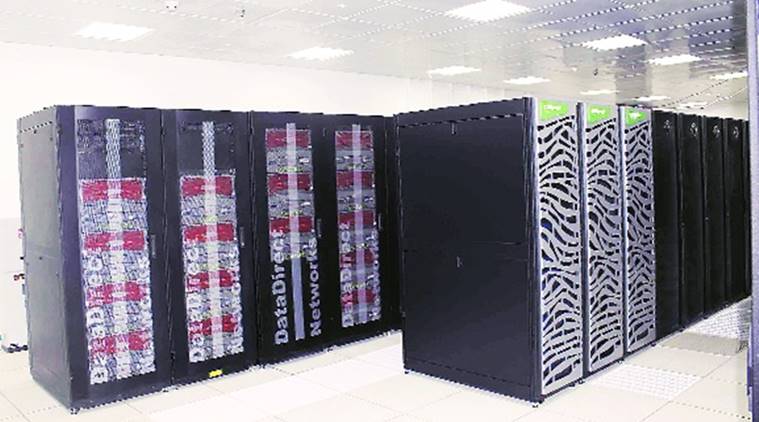 Pratyush is an HPC system used extensively to simulate and predict oceanic and atmospheric systems.
Pratyush is an HPC system used extensively to simulate and predict oceanic and atmospheric systems.
In a first, six-month-old supercomputer Pratyush, dedicated to weather analysis, has taken India to the top positions in supercomputing capacity, globally. It has been ranked as the 39th fastest supercomputer in the world in the Top500 High-Performance Computing (HPC) list.
What is Pratyush ?
It is an HPC system used extensively to simulate and predict ocean and atmospheric systems, both individually and coupled with ocean-atmospheric systems. Its peak capacity is 4 petaflops in compute (1 petaflop=1015 floating point operations per second), has 9 petabytes of storage capacity (1 petabyte = approx 1024 terabytes) and 30 petabytes of archival capacity. The total memory of the whole system is 419 terabytes (1 terabyte = approx 1024 gigabytes). Deployed at the Indian Institute of Tropical Meteorology (IITM), Pune, Pratyush is currently the country’s fastest supercomputer and 39th fastest in the world, according to Top500 HPC rankings released last week.
Did Pratyush improve India’s weather forecasting system?
Within six months of its installation, in January 2018, India has become the only country worldwide to have an Ensemble Prediction System (EPS), running weather models at a 12-km resolution. This system went live on June 1 this year.
The system is being used by the India Meteorological Department (IMD) for generating short range (three to five days) and medium range (four to ten days) weather forecasts. Until now, it was not possible to develop a similar system on the older machines, as the computational requirements were much more demanding than the ones available. Even Europe and USA are running global ensemble forecasts at much coarser resolutions.
Though ensemble systems are commonly used in many countries, Pratyush offers the highest resolution by far, seconded by the HPC run at European Centre for Medium-range Weather Forecasts (ECMWF) offering a resolution of 19 km. Along with Pratyush, Noida-based National Centre for Medium Range Weather Forecasting (NCMRWF), too, has a similar EFS with a 12-km resolution, making India the only country to have two such high-resolution HPCs used exclusively for running weather models.
Advantages of an HPC
This EPS is capable of undertaking advanced calculations and probabilities of extreme weather events — heavy rains, urban flooding, heatwaves, tropical cyclones, storm surge — with much better accuracy. Moreover, outputs obtained by running this high resolution system will particularly come handy at the time of issuing block-level forecast for agriculture, the next ambitious project taken up by the Indian forecasters.
Typically, an area can comprise seven to eight blocks, each spanning anywhere between 10 and 15 km. Inputs obtained from the EPS will significantly help agricultural outlooks given by the IMD and other agencies. Improvements to agricultural outlooks and forecasts are also envisaged as part of the second phase of Monsoon Mission.
In addition, the capability of Pratyush will be utilised to the maximum in furthering India’s forecasts capabilities. Augmentation of modelling capabilities at seasonal (three-four months, with a lead of couple of months), extended range (upto 20 days) and short range (three-five days) are all being taken up in a major way. Pratyush will also be used for undertaking more studies on climate change.
What is the scope of extending the use of Pratyush?
There are plans for developing a prediction and modeling system for thunderstorms and cyclone. Along with the existing prediction systems for these two weather phenomena, scientists will make effective use of this new HPC in carrying out detailed research activities. A new prediction system for thunderstorms is being developed and is expected to be ready by December 2018. With more events of thunderstorm witnessed in New Delhi and other parts of North India during the pre-monsoon season this year, a robust prediction system will be in operation ahead of the pre-monsoon season of 2019.
What is the cost of Pratyush? How many institutions are using the facility?
Pratyush, along with Mihir (deployed at NCMRWF), was collectively built at a cost of Rs 440 crore by Cray XC40 with Intel’s Broadwell processor. Besides the IITM, other institutions under the Ministry of Earth Sciences — Indian National Centre for Ocean Information Services, the National Institute of Ocean Technology, the National Centre for Antarctic and Ocean Research and the National Centre for Earth Science Studies — are currently using the facility. This is IITM’s third HPC after Aaditya and Prithvi. There are no plans at the moment to build any new supercomputing systems.